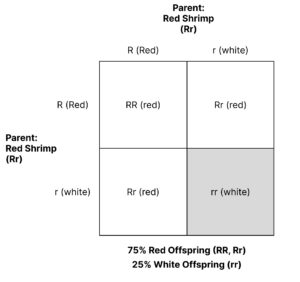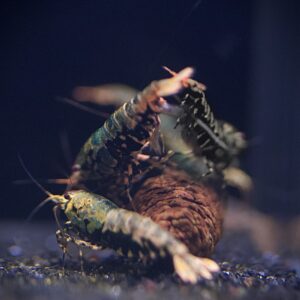When diving into the world of shrimp breeding, two terms you’ll encounter frequently are “genotype” and “phenotype.” Understanding these concepts is crucial for any serious breeder looking to improve their lineages or create stunning new variants.
Genotype refers to the genetic makeup of an organism – it’s the set of genes an individual carries. Think of it as the blueprint or recipe for a shrimp’s characteristics. This genetic information is hidden within the DNA and isn’t always visible to the naked eye.
Phenotype, on the other hand, is the observable physical characteristics of an organism. It’s what we can see, measure, or test – things like color, pattern, size, and even behaviors. The phenotype is the result of the genotype interacting with the environment.
In shrimp breeding, the interplay between genotype and phenotype is paramount. Here’s why:
- Predictability: Understanding the genotype helps breeders predict the potential offspring of their breeding projects. It allows for more informed decisions when selecting breeding pairs.
- Hidden traits: Some traits may be carried in the genotype but not expressed in the phenotype. Knowing the genetic makeup helps breeders work with these hidden traits.
- Consistency: Breeding for specific traits becomes more consistent when you understand the underlying genetics, rather than relying solely on visible characteristics.
- Innovation: Creating new shrimp varieties or improving existing lines requires a deep understanding of both genotype and phenotype. This knowledge allows breeders to push the boundaries of what’s possible in shrimp coloration and patterns.
- Problem-solving: When unexpected results occur in breeding projects, understanding genetics can help diagnose the issue and adjust breeding strategies accordingly.
As we delve deeper into this topic, we’ll explore how to verify genotypes, use basic genetic tools like Punnett squares, and even tackle the complex genetics of sought-after varieties like Boa shrimp.
Verifying Genotype in Shrimp
 Certificates of lineage
Certificates of lineage
Certificates of lineage are valuable documents provided by reputable breeders or shrimp farms that detail the genetic history of a particular shrimp or line. These certificates typically include information about parent strains, generations of selective breeding, and known genetic traits or mutations. When examining a certificate, look for the names or codes of parent strains, the number of generations bred, specific traits or color patterns mentioned, breeding dates, and the breeder’s credentials. While these certificates can be informative, their reliability ultimately depends on the breeder providing them.
Reputable breeders
Sourcing from trusted breeders is crucial in shrimp keeping. Reputable breeders maintain accurate records of their breeding lines, possess a deep understanding of shrimp genetics, and are more likely to provide healthy, genetically stable shrimp. They can also offer valuable advice and support to buyers. To identify reputable breeders, look for those with an established presence in the shrimp-keeping community, who provide detailed information about their breeding practices, offer documentation, have positive reviews, and participate in shrimp competitions.
Multi-generational breeding
Multi-generational breeding is essential for verifying the stability of genetic traits, uncovering hidden recessive genes, improving desired characteristics over time, and understanding inheritance patterns. To conduct and document breeding experiments, start with a clear goal, select breeding pairs carefully, and keep detailed records of each generation. This should include physical characteristics of parents and offspring, the number of offspring displaying each trait, and any unexpected variations. Maintain consistent environmental conditions to minimize non-genetic factors, and be patient – it may take several generations to see clear patterns or results.
It’s important to note the potential issues that can arise when breeding based solely on phenotypes. While it’s tempting to breed shrimp simply based on their appearance, this approach can lead to several problems. First, you might inadvertently introduce or perpetuate undesirable recessive traits that aren’t visible in the current generation but could appear in future ones. Another risk is the potential to introduce random traits to your colony. Sometimes, a desirable phenotype might be linked to less desirable traits that aren’t immediately apparent. This can lead to unexpected and potentially disappointing results in subsequent breeding efforts.
Focusing only on phenotypes can lead to a narrowing of the genetic pool. By consistently selecting for certain visible traits, you might be eliminating other valuable genetic variations that could contribute to the overall health and resilience of your shrimp population. This loss of genetic diversity can make your colony more susceptible to diseases or environmental changes.
A comprehensive approach that considers both genotype and phenotype is crucial. By understanding the genetic underpinnings of your shrimp, you can make more informed breeding decisions that maintain genetic diversity while still working towards your desired traits. This balanced approach helps ensure the long-term health and viability of your shrimp colony while still allowing for the development of beautiful and unique varieties.
Practical Applications for Shrimp Breeders
How to use genotype knowledge in breeding programs
 Understanding genotypes empowers shrimp breeders to make informed decisions when selecting breeding pairs. By considering the genetic makeup of shrimp, breeders can predict potential outcomes of crosses more accurately, work towards specific traits or patterns, avoid unintended reinforcement of undesirable recessive traits, and maintain genetic diversity within their colonies.
Understanding genotypes empowers shrimp breeders to make informed decisions when selecting breeding pairs. By considering the genetic makeup of shrimp, breeders can predict potential outcomes of crosses more accurately, work towards specific traits or patterns, avoid unintended reinforcement of undesirable recessive traits, and maintain genetic diversity within their colonies.
Expert breeders, particularly those in Taiwan, employ meticulous documentation practices. They maintain detailed records for each breeding colony, including lineage information, trait descriptions, known gene involvement, and breeding outcomes. This comprehensive approach allows breeders to track genetic progression over time and make data-driven decisions in their breeding programs.
An often overlooked but crucial aspect of documentation and breeding management is the proper segregation of culls by lineage. This practice is essential for preventing gene pool pollution and maintaining the integrity of breeding lines. By segregating culls, breeders preserve genetic diversity within specific lineages and create a backup in case of loss of ideal specimens in the original breeding colony.
To implement cull segregation:
- Maintain separate tanks or containers for culls from each distinct lineage
- Label each cull group clearly with lineage information and date of separation
- Keep detailed records of why specific shrimp were culled
- Regularly assess cull groups for potential breeding candidates
- Consider genetic diversity when culling from main breeding colonies
This practice ensures that years of careful breeding and genetic development are not lost, allowing for continued experimentation and the potential development of new variants without starting from scratch. If unforeseen circumstances lead to the loss of prime breeding stock, these segregated culls provide a means to continue working with the same genetic lines, albeit with less ideal specimens.
Implementing these comprehensive record-keeping and management practices, including proper cull segregation, sets the foundation for successful, long-term shrimp breeding programs. It allows breeders to make informed decisions, track progress over time, and maintain the genetic integrity of their carefully developed shrimp lines.
Mendelian Genetics and Punnett Squares
Brief overview of Mendel’s laws
Gregor Mendel, often called the father of genetics, established fundamental laws of inheritance through his work with pea plants. His key principles include:
- Law of Segregation: Each organism carries two alleles for each trait, which separate during gamete formation.
- Law of Independent Assortment: Genes for different traits are inherited independently of each other.
- Law of Dominance: When two different alleles are present, the dominant allele will mask the recessive one in the organism’s appearance.
These laws form the foundation of our understanding of genetic inheritance, including in shrimp breeding.
Explanation of Punnett squares
Punnett squares are visual tools used to predict the potential genetic outcomes of a breeding pair. They show all possible combinations of alleles that parents can pass to their offspring. By using a simple grid, breeders can calculate the probability of specific traits appearing in the next generation.
Application to shrimp breeding
- Simple trait example (e.g., color)
Let’s consider a simplified example of red and white shrimp color, where red (R) is dominant and white (r) is recessive. If we cross two heterozygous red shrimp (Rr), our Punnett square would look like this:

This square predicts a 75% chance of red offspring (RR or Rr) and a 25% chance of white offspring (rr) in the next generation.
Limitations when dealing with complex traits
While Punnett squares are useful for understanding simple genetic inheritances, they have limitations when dealing with the complex traits often seen in shrimp breeding:
- Multiple genes: Many shrimp traits, such as pattern or size, are influenced by multiple genes, making predictions more complex.
- Gene interactions: Some genes can influence the expression of others, a phenomenon not accounted for in basic Punnett squares.
- Environmental factors: The environment can affect how genes are expressed, which isn’t reflected in genetic predictions alone.
- Incomplete dominance and codominance: Not all traits follow simple dominant-recessive patterns, leading to a range of phenotypes not easily predicted by basic Punnett squares.
Despite these limitations, understanding Mendelian genetics and Punnett squares provides a crucial foundation for shrimp breeders. This knowledge helps in making informed breeding decisions and understanding the underlying principles of inheritance, even when dealing with more complex genetic scenarios. As breeders gain experience, they often develop more nuanced approaches that combine this basic genetic understanding with practical observations and advanced breeding techniques.
Case Study: Boa Shrimp Genetics
 Description of Boa shrimp patterns
Description of Boa shrimp patterns
Boa shrimp, a popular variety among enthusiasts, are known for their striking snake-like patterns. These patterns typically consist of bold, winding stripes that run along the shrimp’s body, reminiscent of a boa constrictor’s markings. The coloration can vary, but often includes contrasting shades of red, white, and black. The intensity, width, and continuity of these stripes can differ significantly between individuals, adding to the allure and complexity of this variety.
Origins and development of Boa shrimp
The creation of Boa shrimp is a testament to the complexity of selective breeding in the shrimp hobby. While the exact origins are subject to debate, one widely accepted development path suggests a series of intricate crosses:
- Galaxy shrimp: Originally developed from selective breeding of wild-type Caridina cantonensis, focusing on spotted patterns.
- Galaxy to Galaxy Fishbone: Breeding for more pronounced, elongated spots and line across the back.
- Galaxy Tiger: Crossing Galaxy lines with Tiger shrimp (another Caridina variant) to introduce striping.
- Galaxy Snowflake: Developed by selecting for more intricate, snowflake-like patterns within Galaxy lines.
- Boa: Believed to be the result of crossing Galaxy Tiger with Galaxy Snowflake, further refined through selective breeding.
This complex lineage demonstrates the multi-generational effort required to develop the Boa pattern. It’s important to note that breeders continue to experiment, crossing Boas with various other variants to develop new phenotypes. However, this practice can lead to challenges.
Challenges in predicting Boa phenotypes from genotypes
Predicting the appearance of Boa shrimp offspring is particularly challenging due to the complex genetics involved. Unlike simpler traits that follow Mendelian inheritance patterns, Boa patterns can’t be easily predicted using basic Punnett squares. The multiple genes involved and their interactions can lead to unexpected results in breeding projects. Environmental factors may play a role in pattern expression, further complicating predictions. Additionally, because this is a relatively new variant, many lineages of boa do not breed true, there will be a low percentage of offspring that inherit the exact phenotypes of the parents.
The complex origins of Boa shrimp contribute significantly to the challenges in predicting phenotypes. When breeders cross Boas with other variants to create new patterns, they may achieve visually striking results. However, these crosses can lead to genetic instability and unpredictable offspring in subsequent generations. This is often referred to as “gene pool pollution,” and can weaken established breeding lines and make it difficult to consistently produce high-quality Boa patterns.
Current understanding and ongoing research
While our understanding of Boa shrimp genetics has advanced in recent years, many aspects remain a mystery. Current research focuses on identifying the specific genes responsible for different elements of the Boa pattern and understanding how these genes interact. Some breeders and researchers are using sophisticated breeding programs and genetic analysis techniques to unravel these complexities.
Ongoing studies are exploring:
- The role of epigenetics in Boa pattern expression
- Potential environmental factors that may influence pattern development
- Advanced statistical models using AI to better predict breeding outcomes
- The relationship between Boa genetics and other shrimp varieties
As research progresses, breeders hope to gain more precise control over Boa shrimp breeding outcomes. However, the complexity of Boa genetics also highlights the importance of maintaining genetic diversity within breeding populations. Given the intricate genetics involved, it’s crucial for breeders to source Boa shrimp from reputable breeders with established, stable lines. Random intermingling of variants to create visually appealing shrimp often leads to inconsistent results and can dilute the genetic strengths of carefully developed Boa lines. Quality genetics are essential for maintaining the distinctive Boa pattern over multiple generations.
Evaluating Boa shrimp quality
In renowned shrimp competitions, judges evaluate entries based on sets of 4-6 shrimp rather than individual specimens. This practice aims to assess the consistency and stability of the variant’s lineage. Judges look for uniformity in pattern, color, and overall appearance across the set, which can indicate strong, stable genetics.
However, this method has limitations. Skilled breeders with large operations can selectively choose their most similar and highest-quality shrimp from a much larger population. While this demonstrates the potential of their breeding lines, it may not fully represent the consistency of their entire stock.
Therefore, when evaluating Boa shrimp for breeding purposes, consider:
- The reputation and track record of the breeder
- Consistency across larger groups of shrimp, not just select specimens
- Performance over multiple generations
- Transparency about the shrimp’s genetic background
The case of Boa shrimp illustrates the delicate balance between artistic breeding for aesthetic appeal and maintaining genetic integrity. It underscores the importance of responsible breeding practices and the value of preserving and refining established lines alongside the excitement of developing new varieties.










